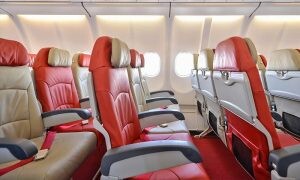Jul 11, 2018 - 10 min
3 KEY USAGE CONSIDERATIONS FOR AIRCRAFT INTERIOR WEB ADHESIVES

Even as aircraft interiors continue to be reinvented, manufacturers must address governmental pressures for increased output, fuel efficiency and safety. Ideal for seating, upholstery and decorative trims, aircraft interior web adhesives are a smart way to meet these requirements while enhancing overall interior aesthetics.
Take a look at three key usage considerations to achieve ideal web adhesive performance.
1. Ensure the Right Melting Temperature
Aircraft interior web adhesives come in a range of melting points to accommodate different applications and substrates. For example, some webs, such as PE75 and PE85, have low melting points to accommodate similarly low melting point foams used in aircraft seating. If a web adhesive has a higher melting point than the foam substrate it is bonding to, the foam will melt before the adhesive and become damaged. On the other hand, some web adhesives have higher melting points and offer greater heat resistance for applications that must endure elevated in-use temperatures, like skin-to-core bonding. Ensure that the web adhesive has the accurate melting point for desired performance.
2. Use Heat and Pressure with Web Adhesives
Web adhesives can be formulated with additive properties to enhance overall aircraft interior bonding. When using web adhesives, be sure to always use at least light pressure when heating and bonding. Due to how the adhesive forms during the manufacturing process, web adhesives shrink directionally if heated without any pressure applied. Instead of infrared heating, always activate web adhesives with heat accompanied by pressure, as in a heated nip roller or electric fusing press to ensure optimal functionality and performance.

3. Consider Pre-Applying Bostik Webs
An added benefit of Bostik web adhesives is the ability to pre-apply them to one substrate and then bond them to another substrate in a secondary process. In addition to heated presses and rollers, Bostik web adhesives can be melted with heated air or radiant heat allowing them to bond to a single substrate. The webs then quickly cool and the material can be rolled up without any tackiness. The thermoplastic nature of the webs allows them to be re-heated and re-activated at a later time to bond to the second substrate. This feature allows for manufacturing flexibility in terms of the timing and processability.
—
Bostik manufactures web adhesives for aircraft interior applications. These nonwoven web adhesives are lightweight and designed to enhance manufacturing processes while improving interiors overall. For more information on these solutions and how they address governmental pressures, visit www.bostik.com.
